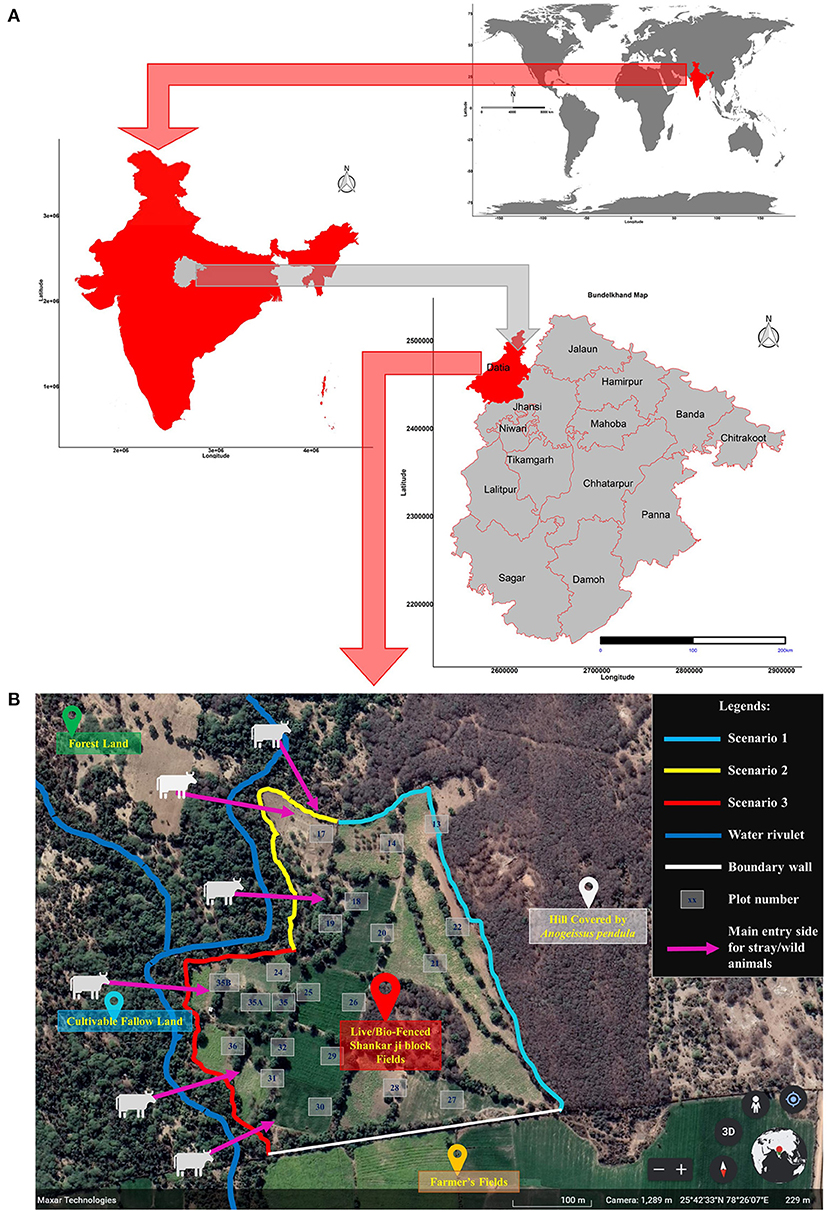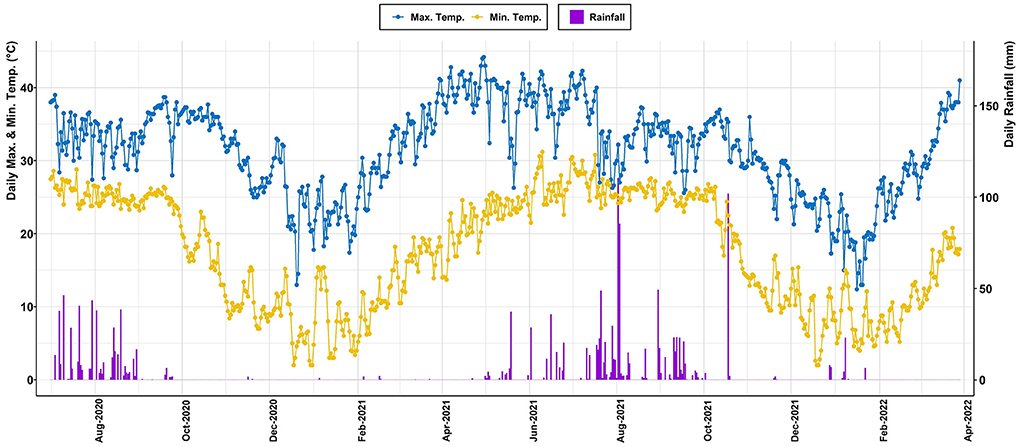- Indian Council of Agricultural Research – Indian Institute of Soil and Water Conservation, Research Center, Datia, Madhya Pradesh, India
Stray/wild animals can cause serious damages to crops, leading to accusations and counter accusations among villagers. In the Bundelkhand region of India, this problem is more severe due to “Anna Pratha,” that is, letting loose animals to open graze. Protective measures employed by farmers (barbed wire fencing, conventional fencing, etc.) are not fully effective and also require periodical maintenance, which involves additional costs and manpower. This necessitates the evolution of a cost-effective and long-term solution to minimize the problem. The current study seeks to evaluate the potential of thorny bamboo (Bambusa bambos) as a bio-fence creating deterrence to stray/wild animals at the ICAR—IISWC RC, the research farm of Datia, Madhya Pradesh, India. After 21 months of planting, bamboo plants attained the maximum plant height up to 4.47 m with the highest clump spread diameter of 30.50 cm. However, the growth of the bamboo bio-fence to be effective depends on the edaphic and management conditions. The findings revealed that planting bamboo at a distance of 80.00 cm in the continuous trench can be an effective bio-fence to avoid man–animal conflict. Huge crop losses were reported before the establishment of a bio-fence. In 2021–2022 (when bamboo plants turned into a closely spaced thicket, making a bio-fence), only two incidents of the invasion of animals were reported with no crop damage. The initial cost to develop a bamboo bio-fence was estimated at INR 5,796 for a length of 100 m. Therefore, the present study suggests that bamboo bio-fencing is an economical and effective crop protection measure against damage by wild/stray animals.
Highlights
- This study involved the systematic development of bamboo-based bio-fence to protect crops from wild/stray animals.
- Closely spaced planting was found to be beneficial for the development of a bio-fence.
- Bamboo-based bio-fence reduced the events of animal intrusion into a cropped field, and thus preventing crop loss.
Introduction
Lately, the increase in stray cattle and wild animals, especially the blue cow, has devastated field crops across the country (India). Sometimes, farmers resort to suicide due to the complete devastation of crops. This menace also gives sleepless nights to farmers, resulting in drudgery and ultimately stress. In the rural areas of India, farmers mostly take care of animals to save their crops. According to the 2019 livestock census report, the total stray animal population in India was 5.02 million (GOI, 2019). Crop damage/losses by wild or stray animals is estimated at 25–60% and in many cases may be up to 100% (HDR, 2012; Goel and Sharma, 2021). In the Indian state Madhya Pradesh, ~2,122 events of crop-raiding occur every month with some degree of variations rendering to crop seasons. The most damaged crops are corn (73.68% responses), wheat (44.74% responses), and gram (36.84% responses), as reported by ABVIGGPA (2021). This problem of stray and wild animals is even more intense in the Bundelkhand region of the country due to the practice of “Anna Pratha.” The Bundelkhand region is situated in the northern part of central India, spreading over a total geographical area of 7,078.80 thousand ha, including seven districts from each of the states Uttar Pradesh and Madhya Pradesh. Approximately 60% of the total area of the Bundelkhand region is cultivable while the rest is covered by other land uses with a forest cover of 20.00% (DACFW, 2019). The region is known for peculiarities like extreme weather situations, undulating topography with shallow red soils, low soil organic carbon, low soil moisture holding capacity, threatened groundwater resources, erratic rainfall, high soil erosion, and frequent crop failures due to droughts (Gupta et al., 2014; Singh et al., 2014; Dogra, 2015; Tewari et al., 2016; Kumar et al., 2021). Livelihood security in the region is adversely affected by biotic pressure on forest and community land, resulting in decreased vegetation cover, fodder, and fuelwood availability (Dev et al., 2016, 2018, 2020), which has further increased the incidence of human–animal conflict. According to Mekonen (2020), the major causes of human–animal conflict are agricultural expansion, human settlement, overgrazing, and deforestation. Farmlands near forest areas are more prone to crop raiding by wild animals, which not only impacts the security of farmers' livelihood but also jeopardizes the wildlife conservation. Forest animals, especially the blue cow (Boselaphus tragocamelus), wild boar (Sus scrofa), etc. enter nearby cropped fields in search of food and damage the crops by eating or trampling by foot. Crop damage concerning yield, as well as economic loss from different kinds of wild animals, has been recited from different parts of India and other countries (Rao et al., 2002; Hariohay and Røskaft, 2015; Hua et al., 2016; Govind and Jayson, 2018; Can-Hernández et al., 2019; McKee et al., 2020; Nair and Jayson, 2021; Raphela and Pillay, 2021). To reduce yield and economic losses, farmers apply a wide range of protection measures including fencing, manual guarding, trenches, and other devices. According to reports (ABVIGGPA, 2021), night watching is maximally practiced as a protective measure (73.70% respondents) followed by firecrackers (63.20% respondents) and fencing (42.10% respondents) with fencing reported to be most effective. Barbed wire fencing, chain-link fencing, and solar-powered fencing are some effective measures to cope with the problem; however they are very costly and require continuous maintenance that poor farmers cannot afford. The majority of farmers construct traditional fences using thorny branches and wooden poles cut from neighboring forests. This is a labor-intensive practice involving family members as the practice also requires maintenance about two to three times every year causing considerable damage to the forest. Bio-fencing, also referred to live-fencing, is a cheap and long-lasting alternative to different kinds of mechanical fencing. Bio-fences are the lines of bushes or trees that are planted closely spaced at field boundaries to provide crop protection against wild/stray animals. In addition to crop protection, bio-fences also act as windbreaks, control soil erosion, enrich the soil, function as carbon sinks, and improve microclimatic conditions (Raich and Tufekcioglu, 2000; Albrecht and Kandji, 2003; Villanueva-López et al., 2016). Bio-fencing can also help in recovering forest cover and conserving the animal in its natural environment (Vadeo et al., 2018). Bio-fencing is expected to recover forest cover and conserve the animal in situ environment (Vadeo et al., 2018). As evidenced by several documents, bio-fencing has a great conservation perspective: they prevent land degradation, influence animal movement, and maintain biodiversity. They also provide ecological habitats and refuge areas for plants, insects, and birds and can form collaborations with other management systems (Pedraza et al., 2022). However, the use of bio-fences around croplands is not common due to many reasons. Bamboo is identically the most versatile and fastest growing plant on earth (Kleinhenz et al., 2003; Chauhan and Kumar, 2005). As a significant forest resource in many countries, bamboo is an exceptional substitute for wood products with several foods and nonfood uses, which has led to an increase in the area under bamboo cultivation globally (Xu et al., 2020). In India, bamboo grows in an area of ~15.70 million ha (Dev et al., 2020). With several multifunctional applications, bamboo has a very high potential to boost farm income and provides a large number of ecosystem services like soil erosion control, climate change, carbon sequestration, water recharge, biodiversity conservation, slope stabilization, and natural resource conservation (Varmah and Bahadur, 1980; Lawler, 1993; Yanhui and Yongmin, 1995; Pande et al., 2017; Dev et al., 2020; Kaushal et al., 2020, 2021; Patra et al., 2021; Rathour et al., 2022). The government of India has decided to bring about 0.10 million ha area under bamboo plantations in farmlands, degraded lands and forests to promote the bamboo sector, create livelihood opportunities, and meet industrial demands (Kaushal et al., 2021). Due to its hasty biomass gathering, bamboo has a high carbon sequestration potential (6–13 Mg ha−1 year−1) with a net primary productivity of 12–26 Mg ha−1 year−1 (Nath et al., 2015). This capacity of bamboo makes it a permanent carbon stock that continues to grow even with selective felling. Keerthika and Chavan (2022) referred that fully grown bamboo produces 300 kg of oxygen per year. The bamboo species Bambusa bambos grows naturally in the soil and environmental conditions of the Bundelkhand region. This species of bamboo can serve very well for the purpose of bio-fencing due to its fast-growing nature, dense thickets, and the presence of very strong and large thorns, which makes it very suitable to prevent animals from entering into the cropped fields. However, there is no systematic study available in the literature including the package of practices to follow to develop an effective bio-fence unit in a short time and this is one of the reasons for less popularity of bio-fencing among farmers. The idea of a bamboo bio-fence was necessitated due to the failure of the barbed wire–cum–thorny twigs fence and night watching to protect crop damages/losses due to grazing by stray cattle and blue cow in the research farm.
As mentioned above, a study on the development of a bio-fence using B. bambos was framed in one of the blocks of the Research Farm, ICAR—IISWC RC, Datia, Madhya Pradesh, India with the following objectives: (i) to test the growth performance of B. bambos as a bio-fence and (ii) to examine the effectiveness of closely spaced planting of B. bambos as a bio-fence. This study hypothesized that closely spaced planting of thorny B. bambos will form a line/fence of the dense thicket in a relatively short time and prevent animals from entering into the cropped fields.
Materials and methods
Study location
The present hypothesis was piloted at the Shankarji block of the research farm of the Indian Council of Agricultural Research—Indian Institute of Soil and Water Conservation Research Centre (ICAR-IISWC RC), Datia, Madhya Pradesh, India located at 25° 42′ N latitude, 78° 26′ E longitude with 229 m elevation from the mean sea level (Figure 1A). Two different types of soils are present in the block: (i) red, coarse-textured gravelly soils and (ii) blackish-brown fine-textured loamy soils. In general, the Bundelkhand region is a hot and semiarid region with an extreme range of temperature from 1.00°C during the winter to more than 40.00°C during the summer. May and June are the hottest months. The distribution of rainfall is highly uneven with more than 85.00% of the total rainfall received from June to September. The average annual rainfall of the region is about 860 mm, and the most amount of this rainfall is lost through runoff (HDR, 2012). Some amount of showers are also received during winters. Drought-like conditions are very common during peak summers. The temperature and rainfall recorded during the study period are shown in Figure 2.
Scheme of testing hypothesis
The scheme of testing hypothesis is illustrated in Figure 1B. The Shankarji block of the institute research farm was selected for this study due to an intensive problem of crop damage by wild/stray animals. One side of the Shankarji block is covered by a boundary wall, while the remaining sides were covered with conventional fencing arrangements, which were insufficient to prevent the invasion of animals. On the sides that have conventional fencing arrangements, one side is covered by a hill and dense forest of Anogeissus pendula trees, while the remaining sides are covered by a small seasonal rivulet and are the main sides for the entry of animals into the cropped block. The overall length of these sides is roughly 1,500 m, necessitating the construction of a fence around the block. These sides of the block varied in soil conditions as well as the density and types of trees/plants growing along with the border bund of block. It is common to observe some kind of plants/trees growing naturally along with field bunds, which were taken into account to note the growth of bamboo plants under such varying conditions. This assists to evaluate the suitability of bamboo plants for the development of a bio-fence in a short period. Considering the aforementioned variations, the total distance to be covered with bio-fencing was divided into three different situations called “scenarios.” The length of each scenario ranges from 400 to 550 m. Treatments, planting conditions, and soil characteristics are given in detail in Table 1. Scenario 1 (S1) had red shallow soils with very low water holding capacity. The borderline of the block with scenario 1 was under continuous shade from A. pendula plants. Scenario 2 (S2) had cultivable fallow lands with dispersed mixed tree vegetation on the border, whereas scenario 3 (S3) featured cultivated fields with dispersed mixed tree vegetation on the border. The soil properties of both scenarios 2 and 3 were uniform.
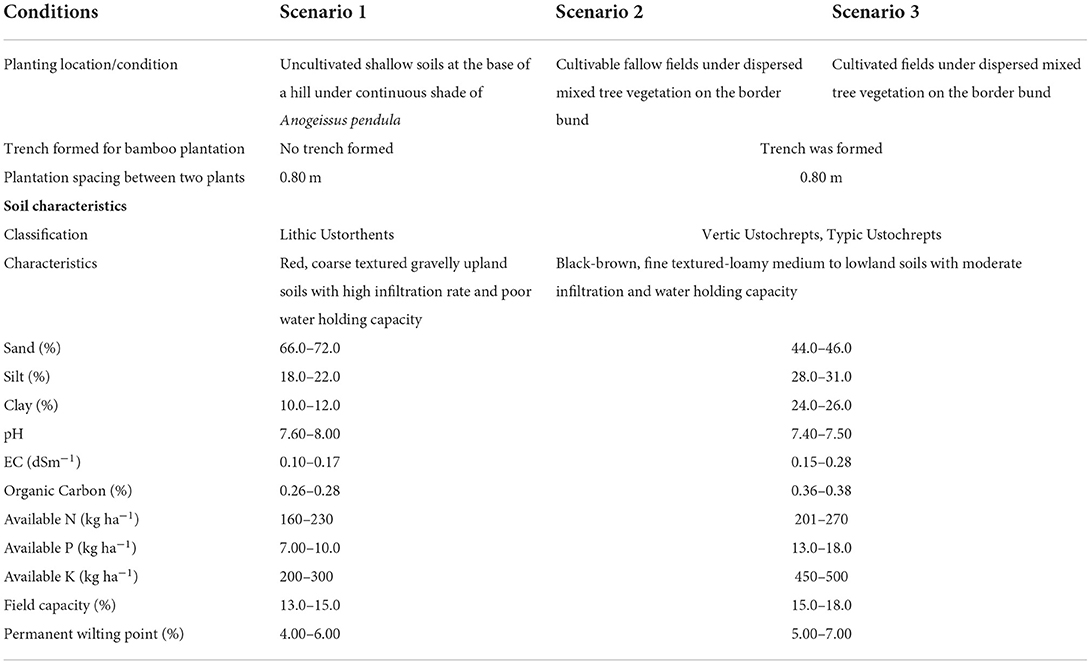
Table 1. Treatments/scenario details include general physicochemical characteristics of soils as a part of treatment/scenario.
Planting procedure to create bamboo bio-fence
Step 1: Development of traditional fence
Although bamboo plants are browsable, but they escape browsing damage with their fast-growing attribute. However, a cost-effective physical barrier is necessary to prevent initial grazing damage to planted bio-fencing saplings. With this objective, a traditional fence was developed along with the proposed bio-fencing line area. Branches of thorny bushes and thorny plants were looped from the nearby forest area, and a fence was established from the looped thorny branches using wooden poles (Figure 3A). This is a common practice followed by farmers in the area to protect their crops from wild/stray animals. However, this fencing is temporary with a restricted shelf-life (<6 months). For a better shelf-life, it requires periodical maintenance. Protection of bamboo plants planted as bio-fence for initial six months will escape browsing them by the stray/wild animals.
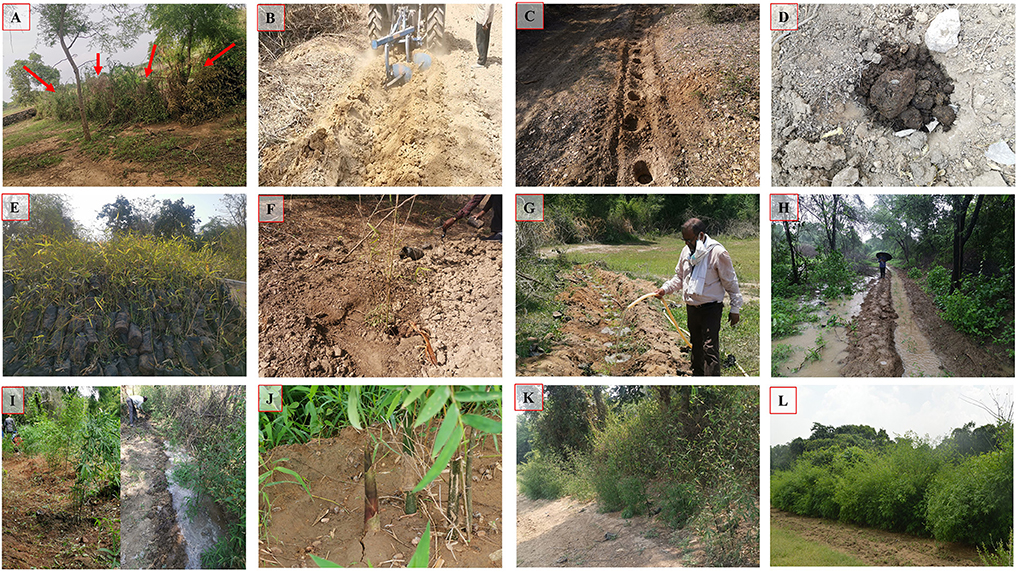
Figure 3. Steps taken to develop bamboo-based bio-fence; (A): the formation of conventional fence using the thorny branches of local available vegetation; (B): the preparation of a trench using MB plough; (C): digging of small pits using tractor-mounted digger; (D): application of farm yard manure (FYM) in pits; (E): planting material used; (F): planted saplings; (G): application of water just after plantation; (H): water conservation in a trench during rains; (I): periodical weeding, inter-cultivation, and irrigation; (J): new culm arising in a 4-month-old plant; (K): in a 9- month-old plants; (L): in 15-month-old plants in the shape able to prevent animal trespassing. Humans appearing in the pictures are the members of research team.
Step 2: Opening of trenches, digging and filling of pits
A trench was opened with the help of a tractor-mounted Moldboard (MB) plough (Figure 3B) at the line marked for bio-fencing. The depth of a trench was around 30 cm with a width of 45 cm. The trench was opened for scenarios 2 and 3 only because the use of the MB plough was not possible in scenario 1. The purpose of the trench was to ease irrigation during the plant growth phase and to conserve rainwater. Later during the rains, the trench conserved enough amount of water (Figure 3H). After opening the trench, small pits (30 cm diameter × 30 cm depth) were dug inside the trench for scenarios 2 and 3 (Figure 3C), while, for scenario 1, the pits were dug at marked points. The distance between the two consecutive pits was kept at 0.80 m. Each pit was filled with 2.50 kg of well-rotten farm yard manure (FYM) and properly mixed with soil (Figure 3D).
Step 3: Plantation and aftercare
Eight-month-old Bambusa bamoos polybag plants were procured from the Social Forestry Division of Forest Department, Bhuta Nursery, Datia (Figure 3E) and appropriately planted in the pre-prepared pits. Plantation was done during the 1st week of July 2020 (Figure 3F). After planting, water was immediately applied to the plants (Figure 3G). The first watering was done using the water tanker mounted on a tractor. Subsequent irrigations were applied by the furrow method in the trench. In scenario 1, an irrigation channel was formed after planting with the help of a spade and irrigation water was applied through this channel (Figure 3I). The interval between the two consecutive irrigations was 7 days during the summer season and 15 days during the winter months. Irrigation was generally not required during the rainy season. A total of four weedings and intercultural operations were performed to keep weeds away from the planting area and to conserve soil moisture. As bamboo is a hardy plant, no special care was required after planting other than irrigation, apart from some weeding and intercultural operations. After a period of 15 months plants were converted into the shape of thickets (Figures 3J–L).
Observations on bamboo plants
The growth parameters of bamboo, namely, plant height, clump spread diameter, number of culms per clump, length and diameter of the first, third, fifth, and seventh internode, and the gap between the two consecutive clumps, were recorded in March 2022 (21 months after planting). All these growth parameters were recorded following the procedure described by Kaushal et al. (2018) and Dev et al. (2020). For the observations, 30 plants were randomly selected from each scenario. Plant height was measured using a handy portable scale and staff gauge. The diameter of clump spread was measured using a vernier caliper. The number of culms was calculated from each selected plant. The average of each study parameter was calculated using the data obtained from these randomly selected plants. To collect data on internodes, three culms were randomly selected from each selected plant and the average length and diameter for the first, third, fifth, and seventh internodes were recorded. The length and diameter of internode were measured using a measuring tape and digital vernier caliper (manufacturer address), respectively. The average gap between the two clumps was noted using a tape measure of randomly selected 15 spots in each scenario.
Recording data on animal entry and crop loss
Field crops were cultivated in the study block during the rabi (winter) season of each year before and after planting the bamboo bio-fence. Night watching, as well as traditional fencing, was the measure to prevent animals from damaging the crops prior to establishing the bamboo bio-fence. After July 2020, bio-fencing was an additional feature added to protect crops from wild/stray animals. Crops cultivated in the block in 2019–2020, 2020–2021, and 2021–2022 were wheat, barley, mustard, and taramira, respectively. Crops were cultivated following the standard package of practices described by ICAR (2013). After sowing the crop, a supervisor visited the study block on a daily basis to examine the invasion of animals and crop damage in the block and along the borders. Any physical entry or signs or footmarks of the intrusion of animals as well as crop damage were recorded by the supervisor or the person engaged in night watching. The entry of animals was identified by footmarks in case of reporting of their invasion and damage in the next morning. Damaged crop area was measured and recorded in square meter for individual plots/crops. The total damaged crop area was summed up for individual crops at the end of crop season every year. Based on the total crop area damaged by animals, financial losses in terms of Indian National Rupee (INR) were calculated. In 2019–2020, there was complete crop damage. In this case, financial losses were calculated using the average yield of a particular crop for the region, market price, and total damaged area. Financial losses during 2021–2022 (observed a partial crop damage) were calculated using the reference yield of a particular crop, the minimum support price for crops, and the total damaged area. The yield of a particular crop from the plots with no damage was used as the reference yield for this purpose.
Cost of a bamboo bio-fence
The cost of a bamboo bio-fence for the initial 21 months was calculated based on the inputs used in different scenarios. The cost of developing a bamboo bio-fence was projected considering market/prevailing rates for various works and inputs, such as plants, machinery rate per hour, daily labor wages, and prices of other inputs. The cost was projected for a 1,500-m length.
Statistical analysis
Statistical analysis of the recorded data on bamboo growth was conducted with the ease of one-way analysis of variance (ANOVA). To test and interpret the scenario effect, the least significant difference (LSD) test at the 5.00% level of significance (p < 0.05) was performed (Gomez and Gomez, 1984). The software R Studio program was used to conduct all kinds of statistical analyses relevant to this study. The graphs were prepared using the ggplot2 package in the R Studio program.
Results
Growth parameters of bamboo
Data on bamboo growth parameters, namely, plant height, clump spread diameter, number of culms clump−1, internode length, and internode diameter, were recorded and analyzed to study the development of thickets formed by closely spaced bamboo plants in bio-fencing lines under different planting scenarios. The data revealed that after 21 months of planting, scenario 3 had the highest plant height (4.47 m) closely followed by scenario 2 (4.25 m). Scenario 1 recorded the significantly lowest plant height (2.66 m). Statistically, scenarios 2 and 3 did not differ significantly from each other in terms of plant height (Figure 4). Data on the number of culms clump−1 and the clump spread diameter are graphically represented in Figure 5A, where the size of bubble represents the clump spread diameter for the individual clump under study. It is clear that scenario 1 has the total number of culms clump−1 in the range of 4.00–10.00, while the number of culms clump−1 for scenarios 2 and 3 were in the range of 6.00–17.00 and 7.00–15.00, respectively. Statistically, scenario 3 reported the significantly highest value for the average number of culms clump−1 (11.13), which differed significantly from scenarios 2 (9.86) and 1 (5.93), as shown in Figure 5B. In case of the clump spread diameter, scenario 2 recorded a significantly higher clump spread diameter (30.50 cm), but did not differ significantly from scenario 3, which recorded the clump spread diameter of 27.70 cm. Scenario 1 recorded the significantly lowest clump spread diameter (Figure 5C). Data on the diameter and length of the first, third, fifth, and seventh internodes revealed that lower internodes had a higher diameter value than upper internodes. Conversely, the length of the lower internodes was less as compared to upper internodes irrespective of the scenario (Figures 6A,B). The diameter of all internodes (first, third, fifth, and seventh) was significantly higher in scenario 3, which did not differ from scenario 2. Scenario 1 had a significantly lower value for internode diameter for all the internodes studied (1stfirst, 3rdthird, 5thfifth, and 7th seventh). The diameter of the first, third, fifth, and seventh internodes in scenario 3 was 26.34, 23.19, 20.49, and 17.14 mm, respectively. Similar trends were observed for the internode length of the first, fifth, and seventh internode, where the internode length was significantly higher in scenario 3 with no significant differences from scenario 2. Different scenarios did not differ significantly from each other in terms of the values recorded for the internode length of the third internode. The length of the lower internode was much smaller than that of the upper internode within the same plant; however, the length of internodes of a similar sequence among different scenarios was largely analogous, ranging from 8.43 to 10.58 cm for the first internode and 19.44–21.64 cm for the seventh internode.
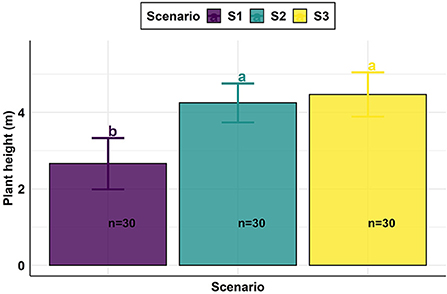
Figure 4. Plant height of bamboo in different planting scenarios. Error bars representing the standard deviation (SD); bars with the similar letter do not differ significantly with each other. S1: Scenario 1; S2: Scenario 2; S3: Scenario 3, a and b: letters to represent a significant difference; m: meter, n: sample size. The least significant difference (LSD) test was used in the context of the analysis of variance (ANOVA), to test whether the difference between the population means is significant or not.
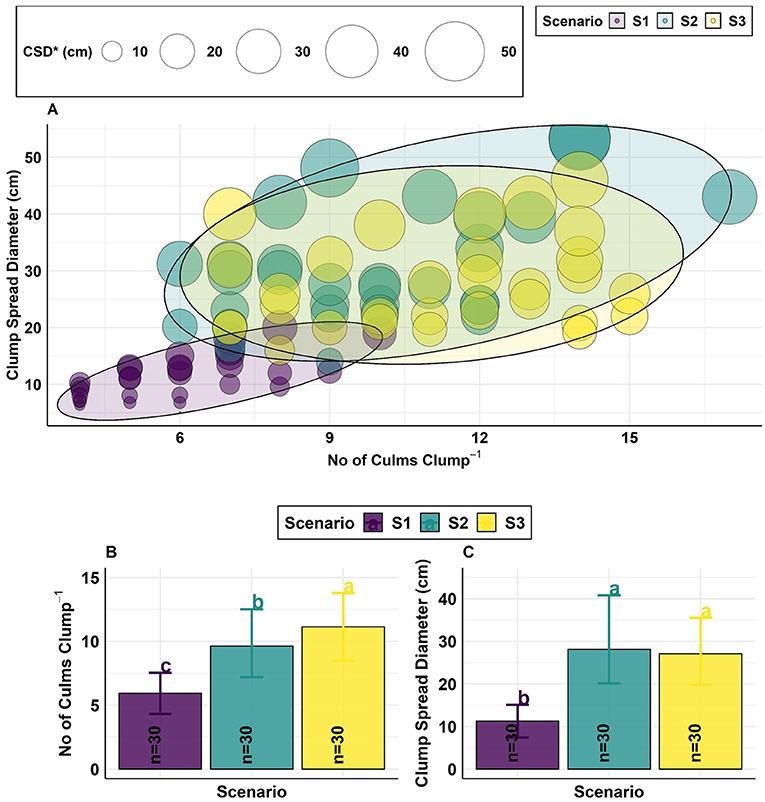
Figure 5. Clump spread diameter vs. the number of culms clump−1 where the size of the point representing the clump spread diameter (A), Average no. of culms per clump (B) and clump spread diameter (C) of bamboo in different planting scenarios. Error bars representing the SD; bars with the similar letter do not differ significantly with each other. S1, Scenario 1; S2, Scenario 2; S3, Scenario 3; a, b and c, letters to represent significant difference; cm, centimeter; n, sample size; CSD, clump spread diameter. The LSD test was used in the context of the ANOVA, to test whether the difference between the population means is significant or not.
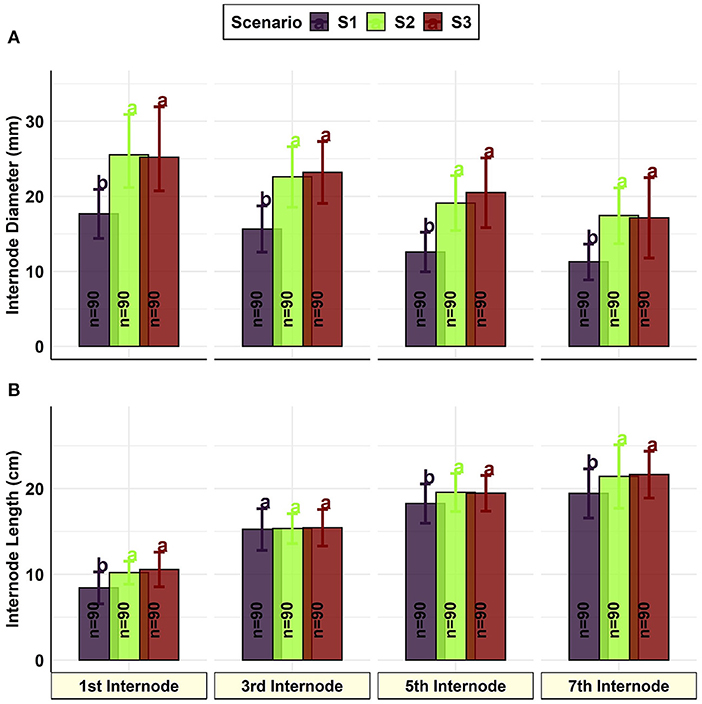
Figure 6. Internode diameter (A) and internode length (B) of bamboo under different planting scenarios. Error bars representing the SD; bars with the similar letter within a scenario do not differ significantly with each other. S1, Scenario 1; S2, Scenario 2; S3, Scenario 3; a and b, letters to represent a significant difference; mm, millimeter; cm, centimeter; n, sample size. The LSD test was used in the context of the ANOVA, to test whether the difference between the population means is significant or not.
Average gap between two consecutive bamboo clumps
In view of developing a biological wall using bamboo plants to prevent the invasion of animals into the cropped fields, the average gap between the two consecutive clumps was recorded (Figure 7). A significantly lower (36.66 cm) and higher (63.93 cm) gap between the two consecutive clumps was observed in scenarios 2 and 1, respectively. The gap between the two consecutive clumps in scenario 3 was 45.40 cm.
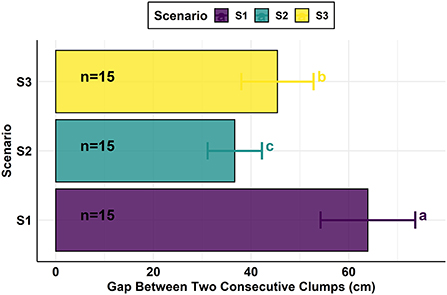
Figure 7. A gap between the two consecutive bamboo clumps under different planting scenarios. Error bars representing the SD; bars with the similar letter do not differ significantly with each other. S1, Scenario 1; S2, Scenario 2; S3, Scenario 3; a, b, and c, letters to represent a significant difference; cm, centimeter; n, sample size. The LSD test was used in the context of the ANOVA, to test whether the difference between the population means is significant or not.
Intrusion of animals and crop loss
Data pertaining to the intrusion of animals and crop losses are presented in Table 2. Crops were sown during the rabi (winter) season of each year. In 2019–2020, barley and wheat crops were sown in different plots of the block. The crop protection measures adopted were traditional fencing (a fence with looped thorny branches and wooden poles) and night watching. In 2019–2020, a total of 10 animal intrusion events were reported in the cropped fields of the block. Flocks of animals mostly crossed traditional fencing arrangements (Figure 8A) to graze crops. Stray cows, blue cows, and wild boars were the animals whose invasion was reported in the block. In 2019–2020, heavy crop damage was reported where 15,000 m2 area for barley and 40,250 m2 area for wheat crop were totally damaged by wild/stray animals with an estimated yield loss of 30.00 and 78.12 q for barley and wheat, respectively, leading to a total financial loss of US$ 2193. The bamboo bio-fence plan was initiated in July 2020, and the mustard crop was sown for the rabi season of 2020–2021. In these years, a total of three events (stray cows, blue cows, and wild boars) of the entry of animals into the block were reported with a total of 6,800 m2 of grazed/damaged crop area, 5.91 q of yield loss, and a total financial loss of US$ 371. These losses were smaller compared to the losses that occurred in the previous year. In 2021–2022, no losses were observed (Figures 8C,D) in terms of crop yield and finance.
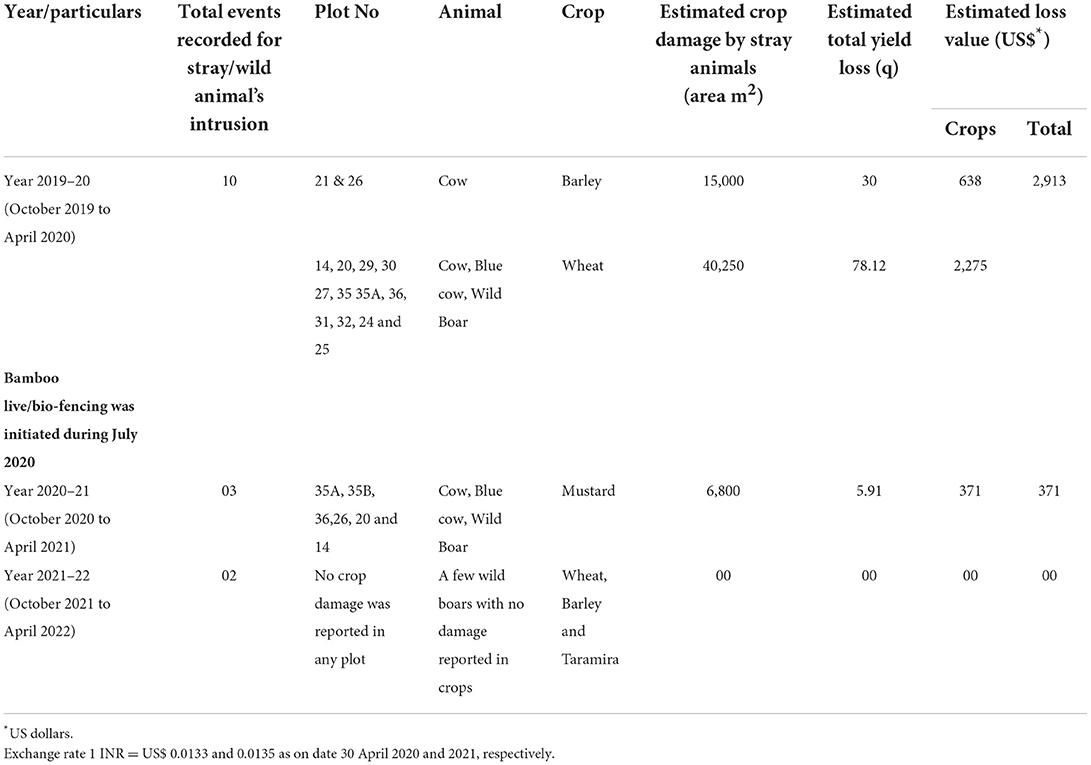
Table 2. Total events of the invasion of wild/stray animals reported into crop plots of the study block, estimated crop damage area, estimated yield loss, and estimated economic loss value due to stray/wild animals grazing in rabi season crops in different years (all three scenarios are taken as the whole bio-fence unit).
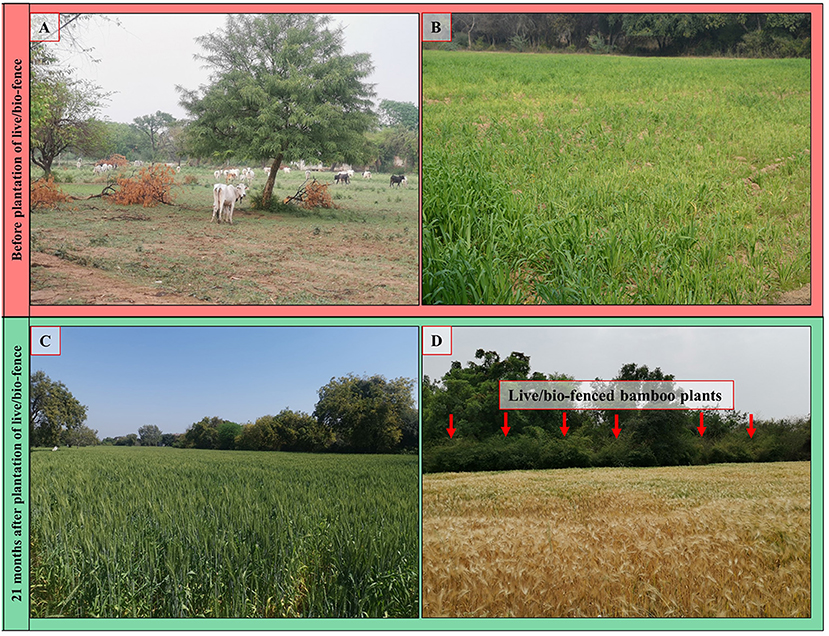
Figure 8. Pictorial view of the herd of stray animals roaming in plot no. Twenty of the study block during August 2019 (A), heavy grazing damage to wheat crop in plot no. 20 of the study block during February 2020 (B), good wheat crop standing in plot no. 20 of the study block during March 2022 (C) and good barley crop on the maturity stage in plot no. 24 of the study block during March 2022 (D).
Initial cost to develop a bio-fence
Data/details pertaining to the cost incurred in the development of a bamboo bio-fence are provided in Table 3. The initial cost (from preparatory works to 21 months after planting) to develop a bamboo bio-fence with a plant-to-plant spacing of 0.8 m was estimated at US$ 1147.57 for 1,500 m and US$ 76.52 for a length of 100 m.
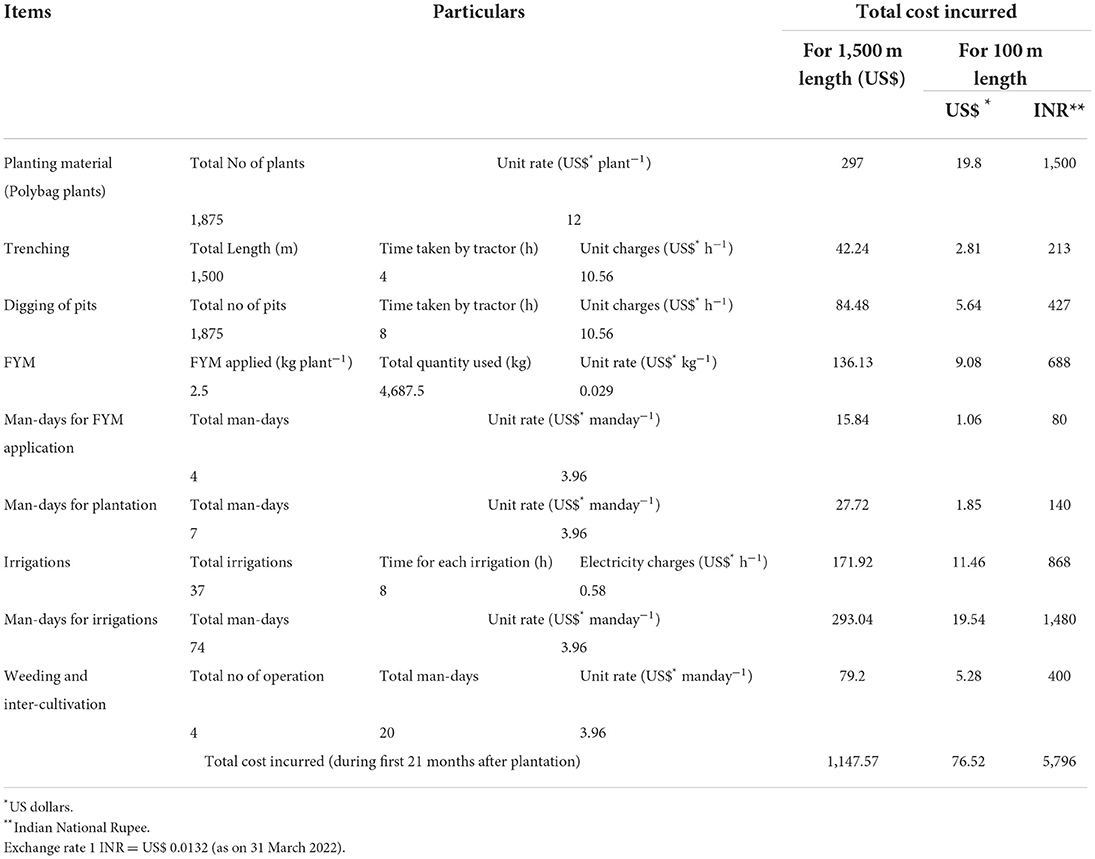
Table 3. Incurred cost for the development of bamboo bio-fence (cost is calculated as per the practices used in S2).
Discussion
Growth parameters of bamboo
The better growth performance of bamboo plants planted for bio-fencing development in scenarios 2 and 3 might be attributed to better soil conditions (texture, depth, nutritional status, and water holding capacity), the formation of a trench for planting and less shade in comparison to scenario 1. The effect of soil behavior, especially texture and soil moisture, on forest variables is also explained by Peña-Claros et al. (2012). Soil type is also another important factor considering its influence on soil moisture and nutrient availability for plants (Potts et al., 2002; Phillips et al., 2003). In our study, soil type in scenario 1 was a coarse-textured, red soil with low water-holding capacity, low field capacity, and permanent wilting point compared to soils in scenarios 2 and 3 that had black-brown fine-textured soils. The authors opined that the shallow soil depth of scenario 1 may be contributing to the slower growth of bamboo plants as soil depth can greatly affect the growth of plants growing in the soil. Generally, deeper soils can provide more water and nutrients to plants compared to light soils (Rajakaruna and Boyd, 2019). Tall woody plants, such as shrubs and trees, rely more on soil depth for mechanical support. However, studies explaining the influence of edaphic factors on bamboo growth are still insufficient. Bamboo is known for its survival in various soil conditions, whether it is grown naturally or planted, but can sometimes be affected by light intensity. Some particular species of bamboo are also influenced by soil conditions (Sofiah et al., 2018). Estrada-Villegas et al. (2020) reported that tree biomass accumulation was significantly affected by soil fertility. As bamboo plants in scenario 1 were under continuous shade from A. pendula, plant growth was slower due to lack of light, which might have affected photosynthesis. Bamboo plants were planted using a trench and pit method in scenarios 2 and 3, while the pit (no trench) was used in scenario 1. Soil moisture-conserving structures, such as trenches, reduce the runoff and increase the opportunity time for water to infiltrate the soil during rains and manual irrigation. This water is then available to plants during non-watering/irrigated or dry periods, which helps plants to produce more biomass compared to plants without trenches or soil moisture harvesting structures (Burton et al., 2000; Panigrahi et al., 2007; Sumbali et al., 2012). The authors suggested that trenching was another major reason behind the better growth of bamboo plants in scenarios 2 and 3. Celma et al. (2019) and Alem et al. (2020) also reported that the establishment of trenches on degraded lands facilitated better growth and biomass production. Better growth and the yield of bamboo shoots with improved soil water availability were also demonstrated by Kleinhenz et al. (2003). Vadeo et al. (2018) observed that in a study of non-bamboo species bio-fencing, the plant survival rate was 70% and the growth of plants was even after 2 years of planting. Considering the different scenarios, the research team was satisfied with the growth performance of bamboo plants to develop a bio-fence.
Average gap between two consecutive bamboo clumps
The average data gap between the two consecutive clumps was recorded to observe the time to fill the available gap between the two clumps so that a biological wall can be developed to prevent trespassing of animals in the cropped fields. Scenarios 2 and 3 were observed to have a low gap available between the two consecutive clumps. It was assumed that the lower gap available between the two consecutive clumps will be more difficult for animals to enter the cropped fields through this gap. A small gap between the two consecutive clumps in scenarios 2 and 3 is attributed to better growth of bamboo and the clump spread diameter, which was higher in these two scenarios. The better growing conditions for bamboo in these two scenarios resulted in a relatively higher number of culms per plant, which in turn resulted in a more spread of bamboo clumps, ultimately resulting in a low gap between the consecutive clumps. The wider gap between the two consecutive clumps of bamboo in scenario 1 was due to relatively slower growth with smaller clump spread diameter. The authors hypothesized that the spread of bamboo clumps will cover more area and reduce the gap between the two plants. As time passes, the gap will be completely filled, and a biological wall will be formed to prevent animals from entering the cropped field. As our results denoted the findings of the initial 21 months, indicating that bamboo plants should be planted at a smaller distance to develop an effective bio-fence to prevent the intrusion of animals. To date, there is no published evidence on suitable spacing to develop a fast and effective bio-fence. The authors decided on this planting spacing based on their general assumption that planting at this spacing would be suitable to cover all available gaps between the two clumps in a short time. The authors opined that a closer spacing (50.00–60.00 cm) would have been better for bamboo plantation to develop a fast and an effective bio-fence. However, more research is needed to identify a suitable space for developing a bio-fence in a short time, preferably within one cropping season.
Intrusion of animals and crop loss
Routinely, incidents of animals entering cropped fields were recorded before and after the establishment of a bamboo bio-fence. Before the establishment of a bio-fence, the block was fenced using conventional fencing practices and with the management of night guarding. It was observed that there was a reduction in the event of animals entering the block as well as crop losses after the implementation of a bio-fence. Although the block was fenced and guarded day and night, entire crops were grazed before the flowering stage (Figure 8B) within few nights in 2019–2020, making the fence and night watching ineffective. In 2019–2020, the fence was a conventional one developed from wooden poles and loop-shaped thorny branches, which were not strong enough to prevent the entry of animals. However, the authors assumed that if there was a strong bio-fence, these losses could have been prevented or reduced. In 2020–2021, there was a reduction in damage to the total crop area compared to 2019–2020. The authors suggested that the bio-fence did not contribute to the reduction in losses in 2020–2021 as the bio-fenced bamboo plants at these times were not strong enough to prevent the illegal entry of animals. The choice of crop planting was considered an important element to reduce losses in 2020–2021 as it has been observed that animals preferred the mustard crop less for grazing than wheat and barley. This might be due to the pungency of mustard leaves. In 2021–2022, bamboo plants formed a continuous and closely spaced thicket, with their thorny branches bumping against one other, forming a bio-fence. Wheat, barley, and taramira crops were sown in the different plots of a block, and only two incidents of the invasion of animals were reported. The intruding animal was observed to be few a wild boars, which are much smaller in size compared to stray cows and blue cows. In these year (2021–2022), no losses were observed (Figures 8C,D) in terms of crop yield and finances. These findings suggest that, with the same level of management, incorporating a bamboo bio-fence can significantly minimize the problem of wild/stray animals (posing a threat to crops) within 2 years. The authors also assumed that a bio-fence thicket along the block boundary would have hindered wild/stray animals from seeing the cropped fields. Secondly, the presence of strong thorns on bamboo plants (Figure 9) might also have helped to keep animals away from the cropped field. However, few entries of wild boars were attributed to their smaller size, which is also expected to stop with further closure of bamboo clumps and the reduction of the gap between bamboo clumps. Similar to our study, WWF (2018) reported a significant reduction in human–elephant conflict as a result of the implementation of solar-powered fencing and bamboo bio-fencing in the Sonitpur district of Assam in India. However, there is not sufficient literature available to support our findings and views.
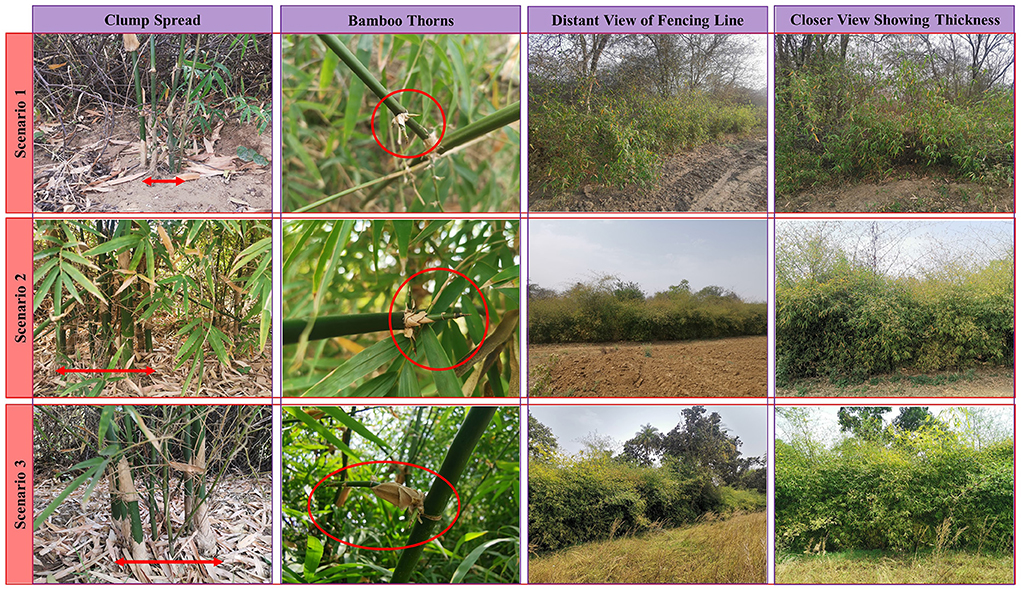
Figure 9. Pictorial comparison of varied clump spread, bamboo thorns, distance, and a closer view of the fencing line under different planting scenarios. All pictures were taken on the same day March 2022.
Initial cost to develop a bio-fence
Considering the local market cost of materials to develop wire, solar, and chain-link fencing, it is clear that mechanical fencing cannot be developed at such low costs. In our study, it is indicated that very little investment is required to develop a bamboo bio-fence. Low-cost development of a bamboo bio-fence is attributed to the easy availability of the planting material at a very low price, less labor requirements of a bamboo plant as it is very hardy by nature, the requirement of less post plantation care, and it is disease and pest resistance. The cost of developing a bamboo bio-fence can be further reduced if the saplings are prepared with bamboo seeds. The economics of the bio-fence, including the total financial benefits, cannot be worked out as the plant has not yet started culm yield. However, in the upcoming 1 or 2 years, it is expected to be a win–win situation, as bamboo bio-fencing plants are expected to provide financial returns through the selective felling mature bamboo culms and selling them to the industry, in addition to reducing yield losses.
Conclusion
In this study, it is demonstrated that planting bamboo (B. bambos) at a distance of 80.00 cm in a continuous trench can be an effective bio-fence to avoid man–animal conflicts and thus protect the crop against damage from stray and wild animals, which keep farmers stress-free within 1–2 years of establishment. The time period to obtain the closure canopy of the bamboo bio-fence for full-proof protection against animals depends on the edaphic conditions. Unlike the other practices of crop protection, the bamboo bio-fence may last more than 50 years. In addition, it is suggested to study on the screening of bamboo species suitable for the region, the standardization of bamboo spacing for early canopy closure preferably in the very first season, the scheme of selective felling of clumps to generate income without affecting the effectiveness of a bio-fence, the shading effect of a bio-fence on crop yields, and the environmental benefits of bamboo bio-fence.
Data availability statement
The raw data supporting the conclusions of this article will be made available by the authors, without undue reservation.
Ethics statement
Ethical review and approval was not required for the animal study because our research was based on the protection of crops from wild/stray animals simply using bio-fences. No physical treatments were imposed on any kind of animal that's why approval was not required.
Author contributions
DKu: conceptualization, investigation, data curation, writing—original draft, formal analysis, and software. RY: methodology, writing—review and editing, and supervision. DKa: writing—review and editing, supervision, resources, and validation. AD and GS: technical support in planting, post plantation care, and data collection. All authors contributed to the article and approved the submitted version.
Acknowledgments
The authors thank the Director, ICAR-IISWC, Dehradun for providing the necessary support to develop a bio-fence. We thank Dr. Rajesh Kaushal (Principal Scientist, ICAR-IISWC, Dehradun) for his guidance on this study. The authors also thank Donald Ghambi, Director of Agriculture Environment and Natural Resources, Chikwawa District Council, P/Bag 1, Chikwawa, Malawi for copyediting this manuscript.
Conflict of interest
The authors declare that the research was conducted in the absence of any commercial or financial relationships that could be construed as a potential conflict of interest.
Publisher's note
All claims expressed in this article are solely those of the authors and do not necessarily represent those of their affiliated organizations, or those of the publisher, the editors and the reviewers. Any product that may be evaluated in this article, or claim that may be made by its manufacturer, is not guaranteed or endorsed by the publisher.
References
ABVIGGPA (2021). Crop raiding compensation procedure, package & implications in Madhya Pradesh. Atal Bihari Vajpayee Institute of Good Governance & Policy Analysis, 1–5. Available online at: https://aiggpa.mp.gov.in/projectdetails/view/UnNOUUVPSVhBWXhEQ1JaRVNGVDI1UT09
Albrecht, A., and Kandji, S. T. (2003). Carbon sequestration in tropical agroforestry systems. Agric. Ecosyst. Environ. 99, 15–27. doi: 10.1016/S0167-8809(03)00138-5
Alem, S., Němec, P., and Habrová, H. (2020). Effects of a trench as a moisture harvesting structure on the biomass production and growth of trees planted to restore degraded land, Southern Ethiopia. Appl. Sci. 23, 8560. doi: 10.3390/app10238560
Burton, P., Bedford, L., Goldstein, M., and Oberg, M. (2000). Effects of disk trench orientation and planting spot position on the ten-year performance of lodgepole pine. New For. 20, 23–44 doi: 10.1023/A:1006796412006
Can-Hernández, G., Villanueva-García, C., Gordillo-Chávez, E. J., Pacheco-Figueroa, C. J., Pérez-Netzahual, E., and García-Morales, R. (2019). Wildlife damage to crops adjacent to a protected area in southeastern México: Farmers' perceptions versus actual impact. Hum. Wildl. Interact. 13, 11. doi: 10.26077/9gqj-5m75
Celma, S., Blate, K., Lazdina, D., Duminš, K., Neimane, S., Štāls, T. A., et al. (2019). Effect of soil preparation method on root development of P. sylvestris and P. abies saplings in commercial forest stands. New For. 50, 283–290. doi: 10.1007/s11056-018-9654-4
Chauhan, S. K., and Kumar, L. (2005). Bamboo: an ideal species for agroforestry in India. Asia Pac. Agrofor. News 27, 14.
DACFW (2019). Agriculture Contingency Plan. Department of Agriculture Cooperation and Farmers Welfare, Government of India. Available online at: http://agricoopnicin/agriculture-contingency-planlisting (accessed July 16, 2019).
Dev, I., Ahlawat, S. P., Palsaniya, D. R., Ram, A., Newaj, R., Tewari, R. K., et al. (2016). A sustainable livelihood option for farmers' of semi-arid region: Bamboo+ Chickpea based Agroforestry model. Indian J. Agroforest. 18, 84–89.
Dev, I., Radotra, S., Ram, A., Singh, J. P., Deb, D., Roy, M. M., et al. (2018). Species richness, productivity and quality assessment of grassland resources in hill agroecosystem of western Himalaya. Indian J. Anim. Sci. 88, 1167–1175
Dev, I., Ram, A., Ahlawat, S. P., Palsaniya, D. R., Singh, R., Dhyani, S. K., et al. (2020). Bamboo-based agroforestry system (Dendrocalamus strictus+ sesame–chickpea) for enhancing productivity in semi-arid tropics of central India. Agrofor. Syst. 94, 1725–1739. doi: 10.1007/s10457-020-00492-8
Dogra, B. (2015). Drought Fails to Crush a Bundelkhand Village. Available online at: https://www.downtoearth.org.in/coverage/drought-failsto-crush-a-bundelkhand-village-4255 (accessed March 2, 2022).
Estrada-Villegas, S., Bailon, M., Hall, J. S., Schnitzer, S. A., Turner, B. L., Caughlin, T., et al. (2020). Edaphic factors and initial conditions influence successional trajectories of early regenerating tropical dry forests. J. Ecol. 108, 160–174. doi: 10.1111/1365-2745.13263
Goel, S., and Sharma, R. (2021). “Assessment of crop damage by wild animals and renewable energy interventions-A case study from coastal Odisha, India,” in 2021 1st Odisha International Conference on Electrical Power Engineering, Communication and Computing Technology (ODICON) (Bhubaneswar: IEEE),1–5.
GOI (2019). 20th Livestock Census-2019 All India Report. Ministry of Agriculture Department of Animal Husbandry, Dairying and Fisheries Krishi Bhawan. New Delhi, 119.
Gomez, K. A., and Gomez, A. A. (1984). Statistical Procedures for Agricultural Research. New York, NY: Wiley.
Govind, S. K., and Jayson, E. A. (2018). Govind, S. K., and Jayson, E. A. (2018). “Crop damage by wild animals in Thrissur District, Kerala, India,” in Indian Hotspots: Vertebral Faunal Diversity Conservation and Management, eds C. Sivaperuman and K. Venkataraman (Singapore: Springer), 309–323.
Gupta, A. K., Nair, S. S., Ghosh, O., Singh, A., and Dey, S. (2014). Bundelkhand Drought: Retrospective Analysis and Way Ahead. New Delhi: National Institute of Disaster Management, 148.
Hariohay, K. M., and Røskaft, E. (2015). Wildlife induced damage to crops and livestock loss and how they affect human attitudes in the Kwakuchinja Wildlife Corridor in Northern Tanzania. Environ. Nat. Resour. Res. 5, 72. doi: 10.5539/enrr.v5n3p72
HDR (2012). Human development report Bundelkhand 2012. Prepared under NITI Aayog-UNDP Project on Human Development: towards Bridging Inequalities. Available online at: https://www.undp.org/content/dam/india/docs/human-development/District%20HDRs/Bundelkhand%20Report_23Jan2018.pdf (accessed April 30, 2020).
Hua, X., Yan, J., Li, H., He, W., and Li, X. (2016). Wildlife damage and cultivated land abandonment: findings from the mountainous areas of Chongqing, China. Crop Prot. 84, 141–149. doi: 10.1016/j.cropro.2016.03.005
ICAR (2013). Handbook of Agriculture. Published by: Directorate of Knowledge Management in Agriculture, Indian Council of Agricultural Research, New Delhi, India.
Kaushal, R., Kumar, A., Dura, J., Mandal, D., Rao, I. V. R., Dogra, P., et al. (2018). Research methodologies for field monitoring analysis and evaluation of resource conservation aspects of bamboos. Int. Bamboo Rattan Organ. 26–41. Available online at: https://www.inbar.int/wp-content/uploads/2020/05/1522831722.pdf
Kaushal, R., Kumar, A., Patra, S., Islam, S., Tomar, J. M. S., Singh, D. V., et al. (2021). In-situ soil moisture conservation in bamboos for the rehabilitation of degraded lands in the Himalayan foothills. Ecol. Eng. 173, 106437. doi: 10.1016/j.ecoleng.2021.106437
Kaushal, R., Singh, I., Thapliyal, S. D., Gupta, A. K., Mandal, D., Tomar, J. M. S., et al. (2020). Rooting behaviour and soil properties in different bamboo species of Western Himalayan Foothills, India. Sci. Rep. 10, 1–17. doi: 10.1038/s41598-020-61418-z
Keerthika, A., and Chavan, S. B. (2022). Oxygen production potential of trees in India. Curr. Sci. 122, 850. doi: 10.18520/cs/v122/i7/850-853
Kleinhenz, V., Milne, J., Walsh, K. B., and Midmore, D. J. (2003). A case study on the effects of irrigation and fertilisation on soil water and soil nutrient status and on growth and yield of bamboo (Phyllostachys pubescens) shoots. J. Bamboo Rattan 2, 281–293 doi: 10.1163/156915903322555568
Kumar, D., Ranjan, R., Meena, M. K., Yadav, R. S., Gupta, G., Jinger, D., et al. (2021). “Exploring conservation agricultural practices in Bundelkhand Region, Central India,” in Conservation Agriculture: A Sustainable Approach for Soil Health and Food Security, eds S. Jayaraman, R. C. Dalal, A. K. Patra, and S. K. Chaudhari (Singapore: Springer), 195–222.
Lawler, D. M. (1993). The measurement of river bank erosion and lateral channel change: a review. Earth Surf. Process. Landf. 18, 777–821. doi: 10.1002/esp.3290180905
McKee, S., Anderson, A., Carlisle, K., and Shwiff, S. A. (2020). Economic estimates of invasive wild pig damage to crops in 12 US states. Crop Prot. 132, 105105. doi: 10.1016/j.cropro.2020.105105
Mekonen, S. (2020). Coexistence between human and wildlife: the nature, causes and mitigations of human-wildlife conflict around Bale Mountains National Park, Southeast Ethiopia. BMC Ecol. 20, 1–9. doi: 10.1186/s12898-020-00319-1
Nair, R. P., and Jayson, E. A. (2021). Estimation of economic loss and identifying the factors affecting the crop raiding behaviour of Asian elephant (Elephas maximus) in Nilambur part of the southern Western Ghats, Kerala, India. Curr. Sci. 121, 521. doi: 10.18520/cs/v121/i4/521-528
Nath, A. J., Lal, R., and Das, A. K. (2015). Managing woody bamboos for carbon farming and carbon trading. Glob. Ecol. Conserv. 3, 654–663. doi: 10.1016/j.gecco.2015.03.002
Pande, V. C., Rao, B. K., Kurothe, R. S., Gopal, K., Sharda, V. N., Mishra, P. K., et al. (2017). Economic assessment of bamboo based soil conservation interventions for reclamation of degraded ravine lands in India: implications for policy intervention. J. Bamboo Ratt. 16, 115–138.
Panigrahi, B., Panda, S. N., and Mal, B. C. (2007). Rainwater conservation and recycling by optimal size on-farm reservoir. Resour. Conserv. Recycl. 50, 459–474. doi: 10.1016/j.resconrec.2006.08.002
Patra, S., Kaushal, R., Singh, D., Kumar, R., Gadedjisso-Tossou, A., and Durai, J. (2021). Surface soil hydraulic conductivity and macro-pore characteristics as affected by four bamboo species in North-Western Himalaya, India. Ecohydrol. Hydrobiol. 22, 188–196. doi: 10.1016/j.ecohyd.2021.08.012
Pedraza, G. Z., Avendaño-Reyes, S., Coates, R., Gómez Díaz, J. A., Lascurain, M., García-Guzmán, G., et al. (2022). Live fences as refuges of wild and useful plant diversity: their drivers and structure in five elevation contrast sites of Veracruz, Mexico. Trop. Conserv. Sci. 15, 19400829221078489. doi: 10.1177/19400829221078489
Peña-Claros, M., Poorter, L., Alarcón, A., Blate, G., Choque, U., Fredericksen, T. S., et al. (2012). Soil effects on forest structure and diversity in a moist and a dry tropical forest. Biotropica 44, 276–283. doi: 10.1111/j.1744-7429.2011.00813.x
Phillips, O. L., Vargas, P. N., Monteagudo, A. L., Cruz, A. P., Zans, M. E. C., Sánchez, W. G., et al. (2003). Habitat association among Amazonian tree species: a landscape-scale approach. J. Ecol. 91, 757–775. doi: 10.1046/j.1365-2745.2003.00815.x
Potts, M. D., Ashton, P. S., Kaufman, L. S., and Plotkin, J. B. (2002). Habitat patterns in tropical rain forests: a comparison of 105 plots in northwest Borneo. Ecology 83, 2782–2797. doi: 10.2307/3072015
Raich, J. W., and Tufekcioglu, A. (2000). Vegetation and soil respiration: correlation and controls. Biogeochemistry 48, 23–36. doi: 10.1023/A:1006112000616
Rajakaruna, N., and Boyd, R. S. (2019). Edaphic factor. Encyclop. Ecol. 3, 361–367. doi: 10.1016/B978-0-12-409548-9.11159-5
Rao, K. S., Maikhuri, R. K., Nautiyal, S., and Saxena, K. G. (2002). Crop damage and livestock depredation by wildlife: a case study from Nanda Devi Biosphere Reserve. Indian J. Environ. Man. 66, 317–327. doi: 10.1016/S0301-4797(02)90587-6
Raphela, T. D., and Pillay, N. (2021). Explaining the effect of crop-raiding on food Security of subsistence farmers of KwaZulu Natal, South Africa. Front. Sustain. Food Syst. 5, 232. doi: 10.3389/fsufs.2021.687177
Rathour, R., Kumar, H., Prasad, K., Anerao, P., Kumar, M., Kapley, A., et al. (2022). Multifunctional applications of bamboo crop beyond environmental management: an Indian prospective. Bioengineered 13, 8893–8914. doi: 10.1080/21655979.2022.2056689
Singh, R., Garg, K. K., Wani, S. P., Tewari, R. K., and Dhyani, S. K. (2014). Impact of water management interventions on hydrology and ecosystem services in Garhkundar-Dabar watershed of Bundelkhand region, Central India. J. Hydrol. 509, 132–149 doi: 10.1016/j.jhydrol.2013.11.030
Sofiah, S., Setiadi, D., and Widyatmoko, D. (2018). The influence of edaphic factors on bamboo population in Mount Baung Natural Tourist Park, Pasuruan, East Java, Indonesia. Int. J. Trop. Drylands 2, 12–17. doi: 10.13057/tropdrylands/t020103
Sumbali, S., Koppad, A. G., and Gurav, M. (2012). Effect of soil moisture conservation structures and application of manures and fertilizers on growth of Acacia auriculiformis. Int. J. Environ. Sci. 1, 178–185.
Tewari, R. K., Ram, A., Dev, I., Sridhar, K. B., and Singh, R. (2016). Farmer friendly technique for multiplication of bamboo (Bambusa vulgaris). Curr. Sci. 111, 886–889 doi: 10.18520/cs/v111/i5/886-889
Vadeo, A. D., Hiese, N., and Hiese, Z. (2018). Study on traditional method of rearing Mithun (Bos frontalis) and application of bio-fencing in Mithun ranges at Porba, Phek District, Nagaland. Res J. Chem. Environ. Sci. 6, 54–58.
Varmah, J. C., and Bahadur, K. N. (1980). Country report and status of research on bamboos in India. Indian For. Rec. Bot. 6, 1–28
Villanueva-López, G., Casanova-Lugo, F., Martínez-Zurimendi, P., Parsons, D., and Aguilar-Solís, L. A. (2016). Effect of live fences of Gliricidia sepium on CO2 fluxes in tropical livestock systems. Soil Use Manag. 32, 553–564. doi: 10.1111/sum.12311
WWF (2018). Apeejay Tea and WWF Announce Outcomes of 3-Year Collaboration on Human-Elephant Conflict Management in Sonitpur. Available online at: ttps://www.wwfindia.org/?17641/Apeejay-Tea-and-WWF-announce-outcomes-of-3-year-collaboration-on-Human-Elephant-Conflict-management-in-Sonitpur (accessed March15, 2022).
Xu, Q. F., Liang, C. F., Chen, J. H., Li, Y. C., Qin, H., and Fuhrmann, J. J. (2020). Rapid bamboo invasion (expansion) and its effects on biodiversity and soil processes+. Glob. Ecol. Conserv. 21, e00787. doi: 10.1016/j.gecco.2019.e00787
Keywords: bamboo, bio-fencing, Bundelkhand region, crop protection, wild/stray animals
Citation: Kumar D, Yadav RS, Kadam DM, Ahirwar LL, Dohare AK and Singh G (2022) Development of bamboo- (Bambusa bambos) based bio-fence to protect field crops: Insights from a study in India's Bundelkhand region. Front. Ecol. Evol. 10:943226. doi: 10.3389/fevo.2022.943226
Received: 13 May 2022; Accepted: 01 August 2022;
Published: 19 October 2022.
Edited by:
Sunil Nautiyal, Institute for Social and Economic Change, IndiaReviewed by:
Jayanta Kumar Patra, Dongguk University Seoul, South KoreaAvijit Ghosh, Indian Grassland and Fodder Research Institute (ICAR), India
Ramesh Kumar Ahirwar, Guru Ghasidas Vishwavidyalaya, India
Vijay S. Meena, The International Maize and Wheat Improvement Center (CIMMYT), India
Copyright © 2022 Kumar, Yadav, Kadam, Ahirwar, Dohare and Singh. This is an open-access article distributed under the terms of the Creative Commons Attribution License (CC BY). The use, distribution or reproduction in other forums is permitted, provided the original author(s) and the copyright owner(s) are credited and that the original publication in this journal is cited, in accordance with accepted academic practice. No use, distribution or reproduction is permitted which does not comply with these terms.
*Correspondence: Dinesh Kumar, ZGsuYWdybzE5OTFAZ21haWwuY29t
 Dinesh Kumar
Dinesh Kumar Ram Swaroop Yadav
Ram Swaroop Yadav Darshan Manikrao Kadam
Darshan Manikrao Kadam